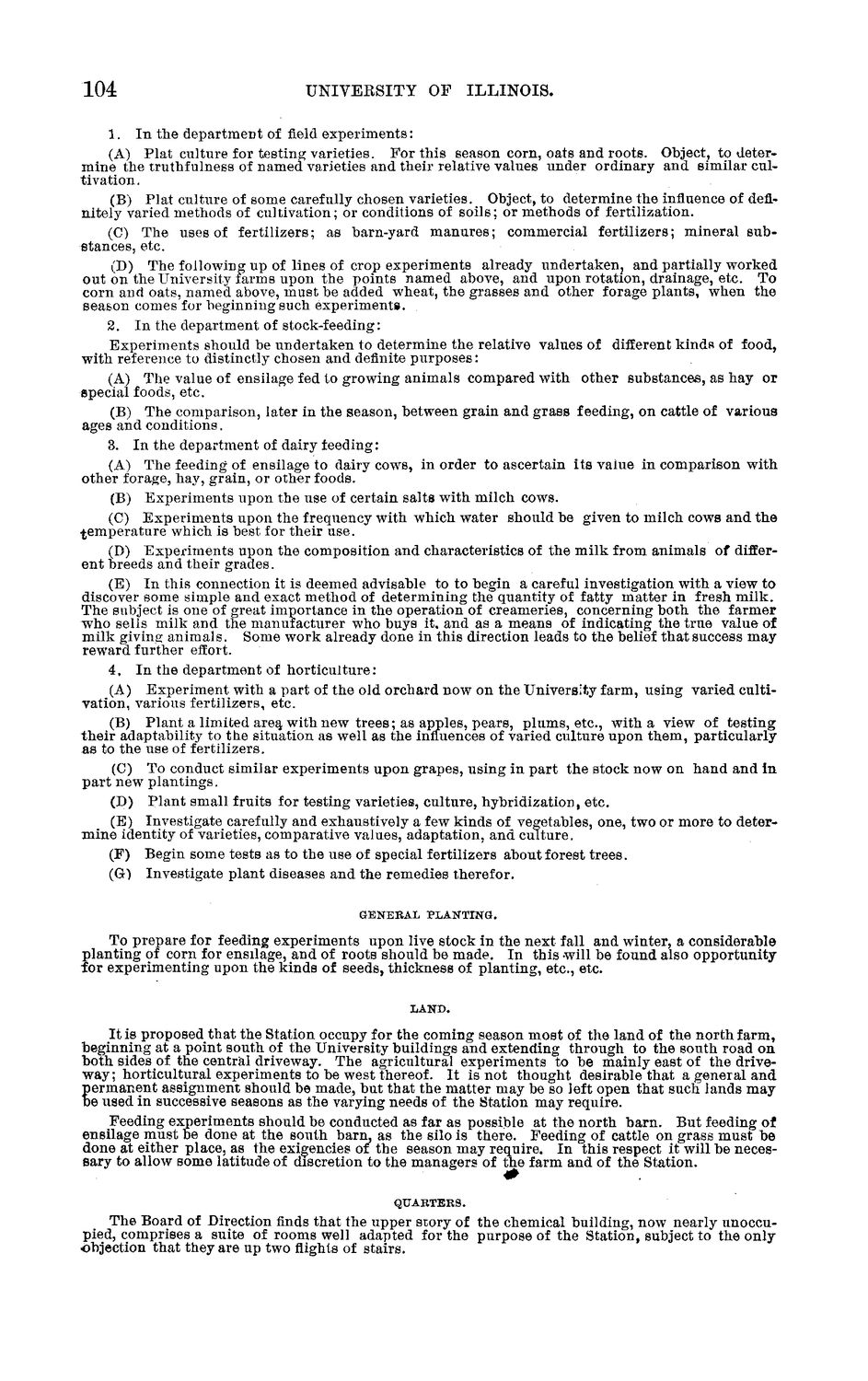| |
| |
Caption: Board of Trustees Minutes - 1888
This is a reduced-resolution page image for fast online browsing.

EXTRACTED TEXT FROM PAGE:
104 U N I V E R S I T Y OF ILLINOIS. 1. In the department of field experiments: (A) Plat culture for testing varieties. For this season corn, oats and roots. Object, to determine the truthfulness of named varieties and their relative values under ordinary and similar cultivation. (B) Plat culture of some carefully chosen varieties. Object, to determine the influence of definitely varied methods of cultivation; or conditions of soils; or methods of fertilization. (C) The uses of fertilizers; as barn-yard manures; commercial fertilizers; mineral substances, etc. (D) The following up of lines of crop experiments already undertaken, and partially worked out on the University farms upon the points named above, and upon rotation, drainage, etc. To corn and oats, named, above, must be added wheat, the grasses and other forage plants, when the season comes for beginning such experiments. 2. In the department of stock-feeding: Experiments should be undertaken to determine the relative values of different kinds of food, with reference to distinctly chosen and definite purposes: (A) The value of ensilage fed to growing animals compared with other substances, as hay or special foods, etc. (B) The comparison, later in the season, between grain and grass feeding, on cattle of various ages and conditions. 3. In the department of dairy feeding: (A) The feeding of ensilage to dairy cows, in order to ascertain its vaiue in comparison with other forage, hay, grain, or other foods. (B) Experiments upon the use of certain salts with milch cows. (C) Experiments upon the frequency with which water should be given to milch cows and the temperature which is best for their use. (D) Experiments upon the composition and characteristics of the milk from animals of different breeds and their grades. (E) In this connection it is deemed advisable to to begin a careful investigation with a view to discover some simple and exact method of determining the quantity of fatty matter in fresh milk. The subject is one of great importance in the operation of creameries, concerning both the farmer who sells milk and the manufacturer who buys it. and as a meahs of indicating the true value of milk giving animals. Some work already done in this direction leads to the belief that success may reward further effort. 4. In the department of horticulture: (A) Experiment with a part of the old orchard now on the University farm, using varied cultivation, various fertilizers, etc. (B) Plant a limited area, with new trees; as apples, pears, plums, etc., with a view of testing their adaptability to the situation as well as the influences of varied culture upon them, particularly as to the use of fertilizers. (C) To conduct similar experiments upon grapes, using in part the stock now on hand and In part new plantings. (D) Plant small fruits for testing varieties, culture, hybridization, etc. (E) Investigate carefully and exhaustively a few kinds of vegetables, one, two or more to determine identity of varieties, comparative values, adaptation, and culture. (F) Begin some tests as to the use of special fertilizers about forest trees. (G) Investigate plant diseases and the remedies therefor. GENERAL PLANTING. To prepare for feeding experiments upon live stock in the next fall and winter, a considerable planting of corn for ensilage, and of roots should be made. In this will be found also opportunity tor experimenting upon the kinds of seeds, thickness of planting, etc., etc. LAND. It is proposed that the Station occupy for the coming season most of the land of the north farm, beginning at a point south of the University buildings and extending through to the south road on both sides of the central driveway. The agricultural experiments to be mainly east of the driveway; horticultural experiments to be west thereof. It is not thought desirable that a general and permanent assignment should be made, but that the matter may be so left open that such lands may be used in successive seasons as the varying needs of the Station may require. Feeding experiments should be conducted as far as possible at the north barn. But feeding of ensilage must be done at the south barn, as the silo is there. Feeding of cattle on grass must be done at either place, as the exigencies of the season may require. In this respect it will be necessary to allow some latitude of discretion to the managers of the farm and of the Station. QUARTERS. The Board of Direction finds that the upper story of the chemical building, now nearly unoccupied, comprises a suite of rooms well adapted for the purpose of the Station, subject to the only objection that they are up two flights of stairs.
| |